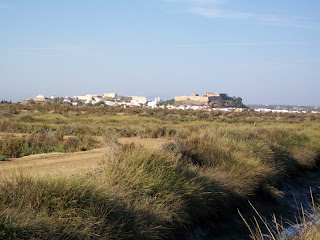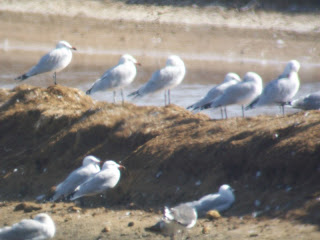Monday 12th October.
A day spent around Cape St. Vincent today, at the south-western tip of Europe. Starting off around the Beliche car park. If you look through Collins field guide, the differences between Crested Lark and Thekla Lark were causing me a few headaches. But it's not quite so bad in the field, definitely bolder markings on the back and breast of a Thekla. We were happy with this one (lifer).

A short walk around this area, and the track on the opposite side of the road produced a Black Redstart, the first of many Choughs for the day, real Rock Doves, Corn Buntings, Spotless Starling, a flyover Blue Rock Thrush and three Black Kites. Martyn also had a male Hen Harrier, which I missed, never mind.
If you drive along this track, with a belt of pine trees to your left, the track will eventually turn to the right and up a small hillock. This is the Cape St. Vincent raptor watchpoint.

We spent the rest of the morning here, waiting for the sky to warm up to see what would pass over. The first hour, from 9am to 10am produced 10 Woodlarks, 1 Grey Wagtail, 1 Tree Pipit, 2 Chaffinch, 7 Linnet, 8 Azure-Winged Magpies and a Peregrine. It was around this point that the Algarve birding guide,
Simon Wates, appeared with a couple he was guiding for the day. Not us by the way!
After 10 it all starts kicking off. First the Sparrowhawks and Black Kites appear, then a low Booted Eagle, Egyptian Vulture, Red Kite, Hobby, then a real bonus of an adult Bonelli's Eagle starting to soar low over the tree line! It was later joined by a second bird. The largest numbers of raptors all seemed to congregate in the sky at around noon, which was when 6 Black Storks appeared. It looked like they were half way to the moon, but still unmistakable to pick out when you get your eye in.
The sheer number of dragonflies in the air were now getting to be a distraction, so time to move on. Crested Tit in the pine wood, then over to the cape itself.

Ah, perhaps we should've come here first thing, full of tourists by the middle of the day, which temperature wise was starting to get a little stifling. The rest of the afternoon was spent exploring fields and heathland. There is a small population of Little Bustard on the cape, but we couldn't find them. We did find a Stone Curlew however, and a large flock of Choughs which contained a few migrant Jackdaws.
We also found a small grove of Fig trees near to the Campismo, from the road between the cape and Sagres. Although nothing rare, plenty of birds around including a Common Redstart, 2 Garden Warblers and a Reed Warbler. The day ended back at the cape for a short seawatch, which included 15 Cory's Shearwaters, 4 Great Skuas, stacks of Gannets and three small Shearwaters. Probably Balearic but we couldn't really tell in the awkward light.
Tuesday 13th October.
Heading north this time, into the plains around Castro Verde, Bustard and Sandgrouse country!

We followed the old
"Finding Birds in Southern Portugal" guide, by Dave Gosney, today. Which is still very accurate and well worth buying to follow the birding sites around here. Although the main road between Castro Verde and Mertola has been resurfaced, leading to very few places to stop and scan.
By the way, en route along the toll motorway is a service station. I really, really wished I'd taken a photo of it but I didn't. Thinking loads of tourists would do the same thing and post it on the internet. Damn you Google image search, I can't find it! This is the nearest thing I can find, which was the name of the motorway service station.

Our first stop was at a place known as "Chimney Pot Hill", north-east of Castro Verde and west of Estradas. A walk up the track quickly produced a male Little Bustard (lifer) and Calandra Lark (lifer). We stopped by the chimney pot to scan. More Black and Red Kites were found, then a monster of a Great Bustard (lifer) flew in.

Two more Great Bustards were found in the area, plus a total of 37 Little Bustards. We also had cracking views of a Calandra Lark while walking back to the car. Well they were all easy, just Black-Bellied Sandgrouse to go now!

Again following Gosney, on the road back to Castro Verde is a farm with a small reservoir. It looked likely spot to find Black-Bellied Sandgrouse coming in to drink, so we decided to check it out. Well, no Sandgrouse here but there were a Black-Shouldered Kite, 2 Snipe, 2 Little Ringed Plovers, 2 Greenshank, 1 Green Sandpiper and I had an almighty shock when I nearly put my foot on a Quail, which took off out of the long grass. That's the first Quail I've ever seen, only ever heard them before.
Incidentally, Castro Verde is a lovely little town. It felt like I had seen a slice of proper Portugal, unlike most places on the coast that are geared up for tourists. We decided to try another area in Gosney. From the road between Castro Verde and Mertola is a road heading south towards Santa Barbara De Padroes, then a left turn towards Guerreiro. Around here in the heat of the day we found a flock of about 30 Griffon Vultures, 2 Ravens, plus 6 Great Bustards and 4 Little Bustards which showed fairly close.

We still hadn't seen Black-Bellied Sandgrouse by now, and weren't really sure where to go. The plains between Castro Verde and Mertola are such a huge area, to cover the whole area properly would take days to do. At one likely looking spot we found a flock of at least 30 Stone Curlews.

As time was getting on, we decided to head back to the Guerreiro road, where we had some success earlier. 17 Little Bustards right next to the road this time, plus 5 Great Bustards that flew over.

Also a covey of 22 Red-Legged Partridge, 10 Azure-Winged Magpies. Then, at 5:30pm, after looking all day, in the distance flew a party of 7 Black-Bellied Sandgrouse (lifer), phew! I had resigned myself to dipping them by now. But it just goes to show, persevere! It was a shame they didn't come nearer to us, but we had worked damn hard all day in order to find them.






















































